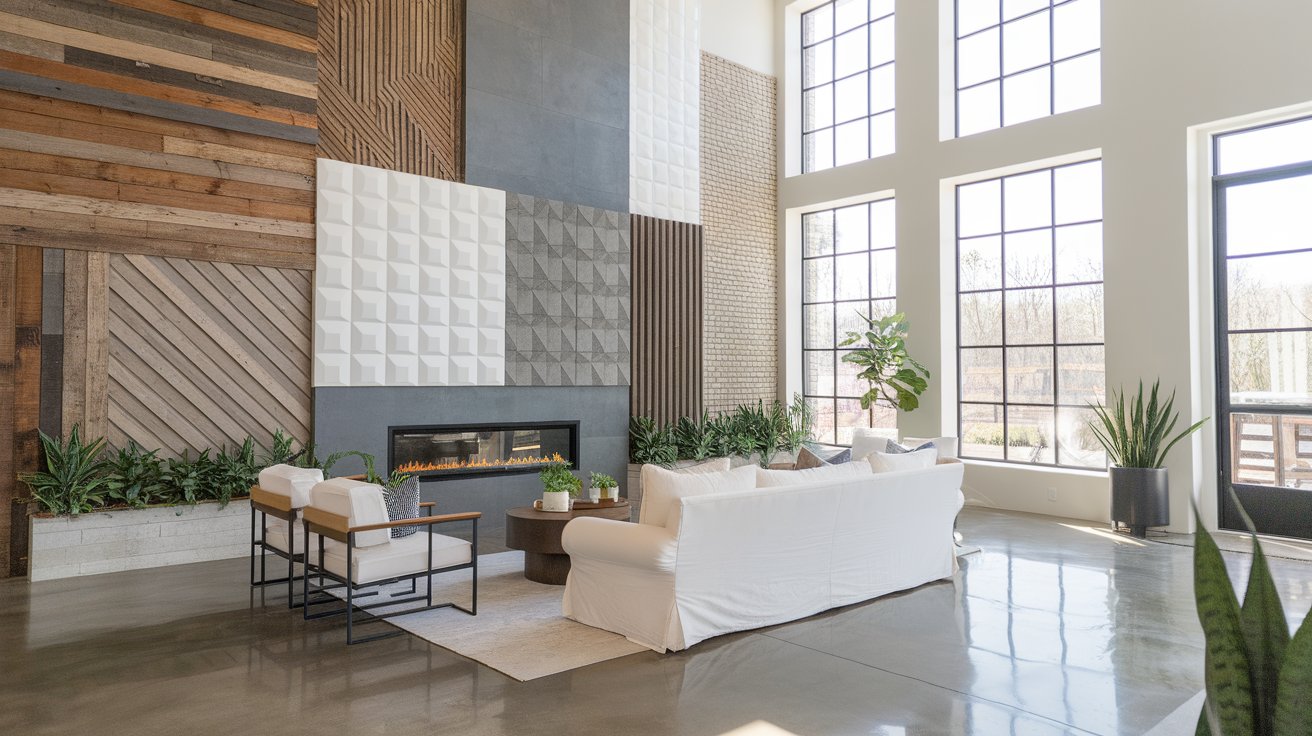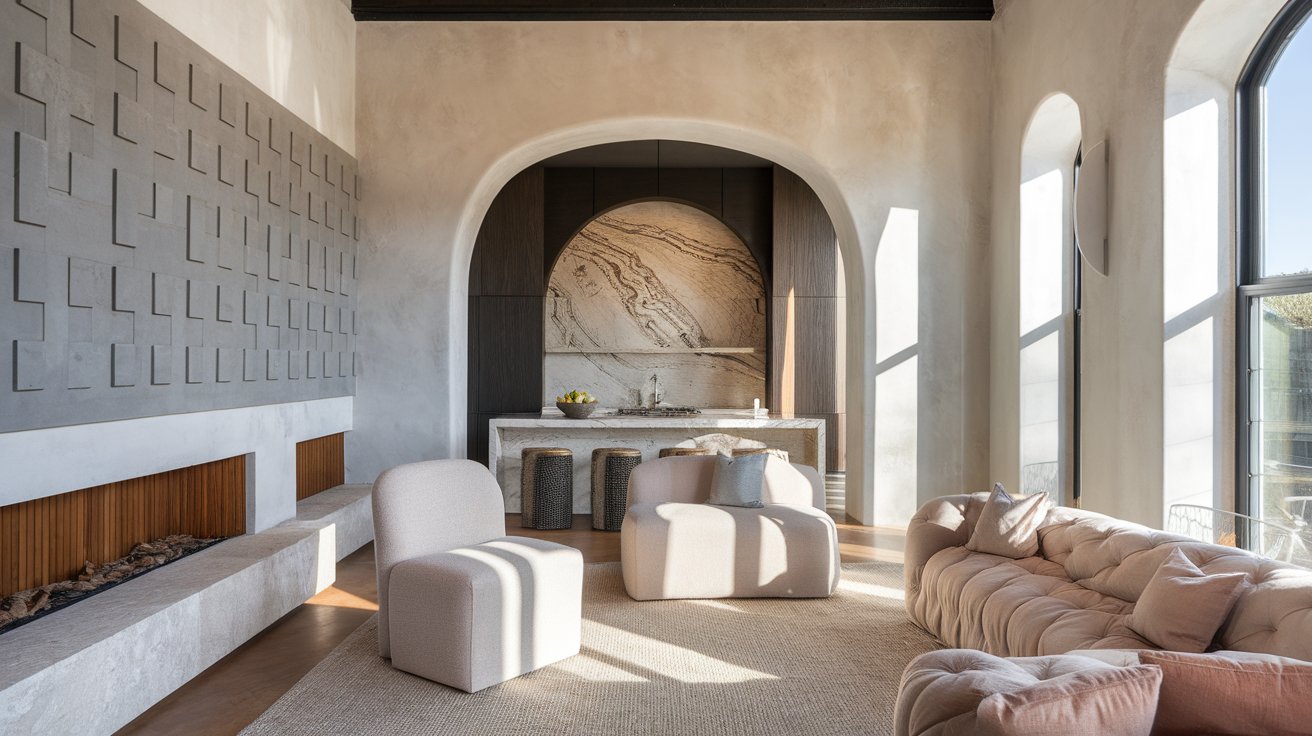Introduction
Creating a sustainable and energy-efficient home starts with the walls that surround you. From natural materials like cork and bamboo to low-VOC paints and recycled plastic tiles, eco-friendly wall finishes offer both style and functionality. These materials are not only better for the environment but also contribute to healthier indoor air quality and improved insulation. By choosing sustainable options, homeowners can reduce their carbon footprint and create spaces that align with their eco-conscious values.
In this article, we’ll explore various eco-friendly wall materials and finishes that can enhance your home’s energy efficiency while keeping the design modern and minimalist. Discover how these solutions are reshaping interior design for a greener future.
Key Takeaways
- Eco-friendly wall finishes improve energy efficiency by enhancing insulation and reducing reliance on heating and cooling systems.
- Low-VOC paints contribute to better indoor air quality, promoting a healthier living environment.
- Natural materials like cork and bamboo offer sustainable and stylish options for wall coverings.
- Recycled plastic wall tiles provide an eco-conscious and artistic solution for interior design.
- Japandi interiors embrace sustainable materials, promoting simplicity and functionality with a minimalist approach.
- Choosing eco-friendly wall treatments helps reduce environmental impact while enhancing home aesthetics.
Eco Friendly Sustainable Wall Finishes for Energy Efficiency
Eco-friendly wall finishes play a critical role in reducing energy consumption and improving insulation. By using friendly wall materials like cork, recycled glass, and natural fibre, homeowners can significantly enhance their indoor climate control. These environmentally friendly materials act as natural insulators, helping to maintain room temperatures and reducing reliance on heating or cooling systems. Incorporating wall finishes with non-toxic and low VOC emissions ensures a healthier living environment, cutting down on harmful chemicals that typically emit from other products. As more people seek sustainable solutions, the rise of water-based, biodegradable coatings and recycled materials is transforming home design. From natural decoration to materials including cork and hallway applications, these elements blend functionality with eco-conscious design. With due respect, the use of renewable source products like bamboo and cork for wall treatments has become increasingly popular, ensuring energy-efficient, sustainable homes.

Cork Wall Panels: A Natural Insulator
Cork wall panels are becoming an increasingly popular choice for homeowners looking to improve energy efficiency. Cork’s natural insulating properties help regulate indoor temperatures, keeping homes warmer in the winter and cooler in the summer. In addition to its insulation benefits, cork is a renewable material harvested without harming trees, making it an eco-friendly choice. Cork panels are also biodegradable and provide acoustic benefits, reducing noise within the home. By integrating cork into your wall finishes, you can reduce energy consumption and create a more sustainable and comfortable living space.
Water-Based Coatings for Lower Energy Use
Water-based wall coatings are another excellent option for reducing a home’s energy footprint. These coatings are made with fewer harsh chemicals than traditional solvent-based paints, ensuring a healthier indoor environment. Moreover, water-based coatings dry faster and help maintain room temperatures, improving energy efficiency. They can be applied on various surfaces, such as walls and ceilings, and provide a long-lasting finish. Opting for water-based coatings contributes to both improved air quality and energy conservation, making them an ideal choice for eco-conscious homeowners.
Top Eco-Friendly Wall Solutions for Sustainable Homes
1. Cork Wall Panels for Insulation
Cork wall panels are an exceptional choice for enhancing home insulation. Not only do they naturally regulate indoor temperatures, but they are also a renewable resource harvested without damaging trees. Cork is both biodegradable and provides acoustic benefits, making it a versatile, eco-friendly option for energy-efficient homes.
2. Recycled Plastic Tiles for Modern Design
For homeowners seeking an artistic touch, recycled plastic tiles offer a creative and sustainable solution. Made from repurposed materials, these tiles help reduce waste while adding a modern flair to any interior. Available in various colors and patterns, they provide both visual appeal and environmental benefits.
3. Low-VOC Paints for Better Air Quality
Low-VOC paints are a practical way to enhance both health and sustainability in your home. These paints significantly reduce harmful emissions, improving indoor air quality. They offer a vibrant finish while ensuring that your living space is free from toxic chemicals often found in traditional paints.
4. Bamboo Wall Coverings for Minimalist Aesthetics
Bamboo wall coverings align perfectly with minimalist design philosophies while promoting sustainability. As a fast-growing, renewable material, bamboo requires minimal resources to produce. Its natural beauty adds warmth to interiors, making it a favored choice in eco-conscious homes.
5. Jute Textiles for Eco-Friendly Texture
Jute, a biodegradable and renewable material, is an excellent choice for adding natural texture to walls. Jute textiles are eco-friendly and provide an organic, rustic feel to interiors, making them perfect for both Japandi-style designs and other sustainable interior concepts.

Eco-Friendly Wall Material Treatments: A Greener Choice
Eco-friendly wall materials, such as cork, bamboo, and reclaimed wood, are excellent choices for reducing the environmental footprint of any space. These sustainable materials are sourced responsibly, often using renewable resources that minimize waste. Whether it’s tiles made from recycled plastic or grasscloth wallpapers, these options not only enhance a room’s aesthetic but also contribute to preserving natural resources. By choosing biodegradable and durable materials, homeowners can create spaces that stand the test of time without sacrificing style or sustainability. Integrating these eco-friendly materials supports a greener, healthier future for the environment and the home.

Reclaimed Wood: Sustainable and Stylish
Reclaimed wood is not only visually appealing but also an environmentally responsible choice for interior wall finishes. By using wood that has already been harvested, often from old buildings or furniture, homeowners reduce the need for cutting down new trees. Reclaimed wood adds a rustic, one-of-a-kind charm to any room, while contributing to sustainable living practices. It is also durable, long-lasting, and requires minimal maintenance. Incorporating reclaimed wood into wall designs supports responsible sourcing and creates a unique, eco-friendly space that reduces the environmental impact.
Recycled Plastic Wall Tiles: Artistic and Eco-Conscious
Recycled plastic wall tiles offer an artistic yet sustainable solution for interior finishes. These tiles are made from repurposed plastic waste, giving new life to materials that would otherwise end up in landfills. Available in various shapes, colors, and textures, recycled plastic tiles add a modern and creative flair to walls while supporting sustainability. They are also easy to install and maintain, providing homeowners with a durable and eco-conscious option. By choosing recycled plastic tiles, you help reduce waste and contribute to a circular economy, all while enhancing your home’s visual appeal.
Case Study: Sustainable Wall Solutions in a Modern Home Renovation
In a recent home renovation project in Seattle, a family focused on reducing their carbon footprint by incorporating sustainable materials into their interior design. One of the key elements was choosing cork wall panels for insulation. The natural insulation properties of cork helped the family reduce their heating and cooling energy usage by 20% in the first year alone. Also, they opted for low-VOC paints throughout the home, which significantly improved indoor air quality, making the environment safer for their children who have respiratory sensitivities.
The family also embraced recycled plastic wall tiles in their kitchen, combining modern design with eco-friendly materials. This renovation not only enhanced the aesthetic appeal of their home but also aligned with their commitment to sustainability, proving that green design can be both functional and beautiful.
Designing with Nature: Japandi and Sustainable Interiors
Japandi design, known for its fusion of Japanese and Scandinavian minimalism, embraces natural, sustainable materials to create serene and functional spaces. By incorporating wood panelling, bamboo, and natural textiles like jute and linen, this style enhances the harmony between the indoor environment and nature. Japandi interiors often feature long-lasting, biodegradable materials that align with eco-friendly values while promoting a minimalist aesthetic. These sustainable choices reduce waste and environmental impact, making them increasingly popular in modern design. The simple, timeless elements of Japandi interiors ensure that these spaces are not only aesthetically pleasing but also aligned with sustainable living practices.

Bamboo Wall Coverings for Minimalist Interiors
Bamboo wall coverings are a perfect fit for the minimalist, eco-conscious approach of Japandi design. Bamboo is a rapidly renewable material that grows quickly and requires minimal resources. Its natural, light texture complements the serene, neutral tones often found in Japandi interiors. Bamboo wall coverings are not only sustainable but also durable and easy to maintain. By integrating bamboo into your home’s design, you embrace the core principles of Japandi—simplicity, functionality, and respect for nature—while contributing to sustainable living.
Jute Textiles: Adding Texture to Sustainable Spaces
Jute textiles are another fantastic option for adding natural texture to Japandi interiors. Known for their eco-friendly properties, jute is a biodegradable material sourced from plants that require little water and no chemical treatments. Jute wall hangings or coverings provide a warm, organic feel to interiors, complementing the minimalist aesthetic of Japandi. By incorporating jute, homeowners not only enhance the visual appeal of their spaces but also promote sustainability through the use of renewable resources.
“Sustainability is not just about doing less harm. It’s about doing more good.” — Jochen Zeitz
Unseen Benefits of Eco-Friendly Wall Solutions
Eco-friendly wall solutions offer more than just a sustainable option—they provide hidden benefits that enhance both health and comfort. Materials like low-VOC paints and natural plasters improve indoor air quality by minimizing harmful emissions, making living spaces safer and more pleasant. On top that, many of these sustainable finishes are crafted from renewable resources, reducing their impact on the environment. Homeowners can also expect these materials to be durable and easy to maintain, often outlasting traditional options. By choosing eco-friendly finishes, individuals contribute to healthier homes and environments while enjoying the timeless appeal and durability these solutions offer.

Low-VOC Paints: Health and Environmental Benefits
Low-VOC paints are a game-changer when it comes to improving indoor air quality. Traditional paints release harmful volatile organic compounds (VOCs) that can linger in the air and affect health. In contrast, low-VOC paints significantly reduce these emissions, creating a safer and more comfortable environment. Also, these paints contribute to sustainability by being less harmful to the environment during production and application. Choosing low-VOC paints means you are prioritizing both your family’s health and the planet’s well-being, without compromising on quality or durability.
Natural Plasters: Durability Meets Sustainability
Natural plasters, such as lime or clay-based plasters, are eco-friendly alternatives to conventional wall coatings. These materials are sourced from the earth and contain no synthetic chemicals, making them safe for both the home and the environment. Natural plasters are breathable, which helps regulate moisture and improves indoor air quality. They are also durable and long-lasting, often outlasting traditional paints. By opting for natural plasters, homeowners contribute to a more sustainable lifestyle while enjoying the timeless beauty and functionality of these eco-friendly finishes.
Conclusion
Eco-friendly wall treatments are more than just a trend; they are a significant step toward creating healthier, more energy-efficient homes. Whether it’s using low-VOC paints to improve indoor air quality or integrating natural materials like bamboo and cork for better insulation, these sustainable choices help protect the environment while enhancing living spaces. By embracing these options, homeowners can take meaningful actions toward reducing their energy consumption and minimizing their environmental impact.
Incorporating eco-friendly wall finishes not only aligns with sustainable living practices but also creates a more comfortable, aesthetically pleasing environment. As we continue to explore greener interior design solutions, these innovations will likely play a central role in shaping the future of home decor.

![CLOUDY BAY [6 Pack] 6inch Smart WiFi LED Recessed Lights,RGBCW Color Changing Recessed Lighting,Compatible with Alexa and Google Home Assistant,No Hub Required,15W 2700K-6500K,CRI90+ Wet Location](https://m.media-amazon.com/images/I/41H5465vC2L.jpg)




